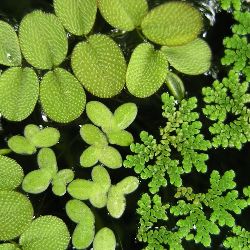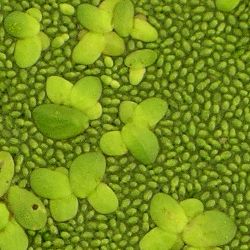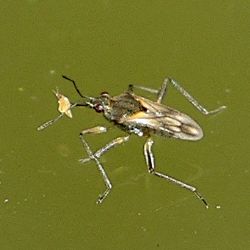
Water Strider
Another liquid landscape that caught my attention was the surface of our garden ponds. As with tiny trails of rushing water, the glassy flat expanse where calm water meets air fired my imagination. I loved to ice skate in the winter, but what if I were small enough to skate on liquid water in the same way? I watched water striders and whirligig beetles as they zoomed about on their limited plane of existence. Feathers, seeds and small flies could easily land on water and not even get wet. What an alien world it must be; sort of like Flatland, but much more interesting because there really would still be three dimensions. I thought it would be somewhat like the vast flat area of Death Valley, or perhaps like walking on acres of a glass pane.
All imaginative musings aside, the water's surface IS quite interesting. A whole community of plants and animals exploits the unique properties of this, well, property. Obviously, only small organisms can utilize this habitat, but they are wonderfully adapted to a lifestyle which involves staying on the upper side of an elastic and dynamic membrane.
 Water Strider |
It might seem impossible, but duckweed and the much tinier watermeal, which are even smaller than the aforementioned ferns, are flowering plants. In fact, they are the world's smallest flowering plants. As might be surmised from the way they grow exponentially on still water, they don't often rely on sexual reproduction, and instead usually simply produce vegetative clones. I was wondering how they are pollinated and was surprised to find out that they actually produce nectar and lure insects to disperse their pollen. Of course, the nectar is a miniscule little droplet and the intended insect assistants are springtails (which aren't even insects anyway) and other tiny residents of the water surface world. For such tiny flowers, their pollination is actually pretty complex. After the initial animal-assisted pollen dispersal, the grains dry out and become airborne, so duckweed pollination uses both insects and wind. There are formal terms for these processes: entomophily and anemophily.
Some plants use water to provide pollination. It's not very widespread, but hydrophily occurs with eelgrass, a common water weed that grows in rivers and ponds in our area. The female flowers float at the surface, waiting to collect the male pollen grains that are released from neighboring plants. The female flowers are easy to find but I have yet to actually see the male pollen clusters.
Plants are interesting enough, but animals are more so, at least in my humble opinion. There are no vertebrates that can call surface tension home, so this landscape is populated mostly by arthropods. The largest can only occasionally traverse open water and more often just do it for short bursts when they feel threatened and need to flee. Rather sizeable spiders come to mind. Wolf spiders (lycosidae) can sometimes skitter across the water, but fishing spiders (pisauridae) make a habit of doing this. They can also cross the threshold and dive beneath the surface when evasive action is needed.
Stepping down a bit in size from the spiders, the largest insects that live on water are the water striders, or pond skaters, and the whirligig beetles. These are the quintessential masters of the surface tension and live their entire lives on the water, where they hunt and scavenge prey, as well as mate and lay eggs. While the striders are thin and leggy, the beetles are compact and look like little seeds racing around in clusters. When viewed up close, it is possible to see the way the water film curves downwards under the weight of these creatures. They seem to live on the edge and might at any moment break through the layer that holds them and sink. But it hardly ever seems to happen, at least not while I am watching.
 salvinia, duckweed & azolla |  duckweed & watermeal |  small water strider eating springtail |
Besides the obvious larger insects there are all manner of tinier ones. Smaller cousins of the water striders, imaginatively called small water striders, also zip around on the surface. Smaller still, the water measurers and water treaders calmly walk about on surface film as if it were a sidewalk. At the smallest end of the spectrum that I have been able to observe, little flies and miniscule beetles wander about. Springtails, which used to be considered insects but are now classified as non-insect hexapods, can form dense mats on the edges of ponds, as if dust has accumulated on the water. But when disturbed, they scatter in all directions!
Thanks to the advantage of digital photography, some of these diminutive denizens can be observed. What looks like an inorganic mote to my unaided eye turns out to be a tiny animal when viewed on the computer screen. The smooth background of the water adds an otherworldliness to this realm that we can only study from a distance and enter only with our imagination.